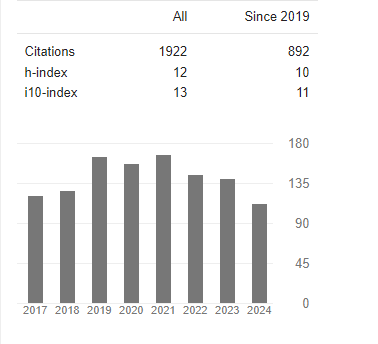Synthesis and Structural Studies on some Dioxomolybdenum (VI) Complexes Bearing 1-(1-Hydroxynaphthalen-2-yl) Ethanone Moiety
Abstract
Mohammad S El-Shahawi, Mai Mostafa A Hassan Shanab, Mohsen M Mostafa
A number of new molybdenum complexes Cis-MoO2 (NE)2 .CH3 OH, Cis-MoO2 (HRSB)2 .nH2 O {R= H, 4-Br, 4-OCH3 , 4-CH3 and n= 0, 1, 2} Cis-MoO2 (HL)(acac).nH2 O {HL= HNEBH, HNEINH, HNENH, HNEPH, n=0, 1}, Cis-[MoO2 (L\)2 .nH2 O], {L\= HNE-2-ABH, HNE-4-ABH, n = 0, 2} and Cis-[Mo2 O5 (HNEAH)2 ] have been synthesized and characterization by magnetic, spectroscopic (FT-IR, 1H and 13C-NMR spectra) and electrochemical techniques. The complexes were made reaction of Cis-MoO2 (acac)2 with the ligands, (1-hydroxynaphthalen-2-yl)ethenone (HNE), (E)-2-(1-(phenylimino)ethyl)naphthalen1-ol (HASB), (E)-2-(1-(p-tolylimino)ethyl) naphthalen-1-ol (HTSB), E-2-(1-(4-methoxyphenylimino)ethyl)naphthalen-1-ol (HMSB) and (E)-2-(1-(4-bromophenylimino)ethyl)naphthalen-1-ol (HBrSB) monobasic bidentate (NO) or 2-anmino-N/- (1-(1-hydroxynaphthalene-2-yl)ethylidene)benzohydrazide (HNE2-ABH), 4-anmino-N/-(1-(1-hydroxynaphthalene-2-yl) ethylidene)benzohydrazide (HNE4-ABH), N/-(1-(1-hydroxynaphthalene-2-yl)ethylidene)benzohydrazide (HNEBH), N-(1-(1-hydroxynaphthalene-2-yl)ethylidene)acetohydrazide (HNEAH), N/-(1-(1-hydroxynaphthalene-2-yl)ethylidene) nicotinohydrazide (HNENH), N/-(1-(1-hydroxynaphthalene-2-yl)ethylidene)isonicotinohydrazide (HNEINH), N/-(1- (1-hydroxynaphthalene-2-yl)ethylidene)picolinohydrazide (HNEPH), they coordinate as dibasic tridentate (OON). Both the molecular and the spectroscopic studies showed that, the complexes are octahedrally coordinated. The redox properties, of the electrode couples and the stability of some complexes towards reduction were linked to the electron withdrawing or ability releasing of the substituent in the Schiff bases and the hydrazones. Results show that, changes in E1/2 for the complexes due to remote substituent effects could be related to changes in basicity of the carbonyl oxygen of the hydrazide moiety in the hydrazone ligand. The electron-donating substituents stabilized Mo(VI) complexes while electron-withdrawing groups favored lower oxidation state of Mo(V) and/ or Mo(IV) species. The nature of mechanism and kinetic parameters of the electroactive chelates are strongly dependent on the substituent. The EHOMO and ELUMO level, of hydrazone and some of Cis-molybdenum complexes, from both electrochemical and theoretical data also backdonation energy (ΔEback-donation), ionization potential (I), molecular dipole moment (μ), electronegativity (χ), softness (σ) electron affinity (A), global hardness (η), and electrophilicity index (ω) were calculated.



